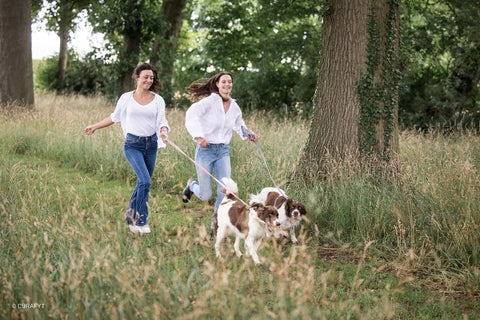Like us, humans, dogs can contract all kinds of age-related ailments as they get older. Osteoarthritis is a very common and painful inflammation caused by a degeneration of the joint cartilage. As a dog owner it is important to recognise the onset of osteoarthritis early on so that you can support your dog with the appropriate exercise and the right food and nutritional supplements.
What is osteoarthritis in dogs
Osteoarthritis or arthritis is a painful inflammation of your dog’s joints, most often caused by wear and tear. All joints can be affected but the knees, elbows, hips, toes, and vertebrae are particularly prone.
A joint is situated between two bone ends. These bone ends are covered with cartilage, a soft tissue without blood vessels or nerves. Cartilage acts as a shock absorber. The fluid inside the joint, known as the synovial fluid or synovia, lubricates the cartilage during movement and supplies it with nutrition.
Osteoarthritis causes damage to the cartilage, reducing its ability to absorb shocks. It also changes the composition of the synovial fluid so that lubrication is impaired. The associated inflammation further ‘destroys’ the cartilage.
What dogs are prone to osteoarthritis?
Older, large-breed dogs are particularly prone, but all dogs of all ages can contract the condition. Dogs with other joint conditions like hip and elbow dysplasia, including dogs who, for instance, underwent knee surgery in the past are also more prone to osteoarthritis.
Did you knos that the early symptoms of osteoarthritis are often confused with ‘getting older’? Make sure to take your dog to the vet if you notice that he is becoming less flexible. Old age is not an illness, but osteoarthritis is!
How to spot osteoarthritis in your dog?
-
Stiffness
-
Decreased willingness to walk and preferring shorter walks
-
Difficulties getting up and lying down
-
Struggling to get in or out of the car
-
Sitting or lying down during walks
-
Being less cheerful, becoming grouchy even
-
Pain reaction when touched
-
Lameness, especially after lying down for an extended period of time, which can go away while walking
Did you know that dogs suffering from osteoarthritis rarely squeal or whine? That is because the pain associated with osteoarthritis is a chronic pain. Dogs only tend to squeal or whine when they experience an acute shooting pain because they made a wrong movement. In other words, don’t wait until your dog squeals or whines before taking action!




Kommentarer (0)
Det finns inga kommentarer till artikeln. Var först med att kommentera!